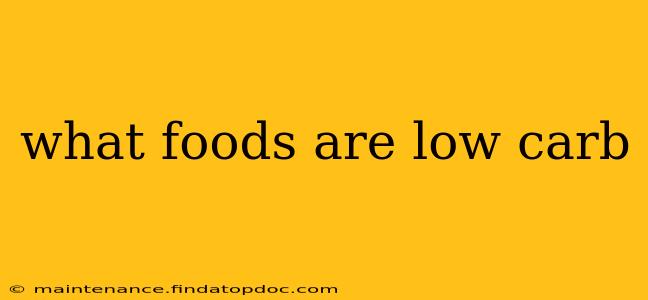Embarking on a low-carb diet can feel overwhelming, but understanding which foods to include is the key to success. This comprehensive guide will explore a variety of low-carb options, helping you create delicious and satisfying meals while staying within your dietary goals. We'll cover various food groups and answer common questions to demystify low-carb eating.
What are the benefits of a low-carb diet?
Before diving into specific foods, let's address the potential benefits often associated with low-carb diets. Many people find that reducing carbohydrate intake leads to weight loss, improved blood sugar control, and increased energy levels. However, it's crucial to remember that individual results vary, and consulting a healthcare professional before making significant dietary changes is always recommended. The benefits are often linked to a reduction in insulin resistance and improved metabolic function. Some studies also suggest potential benefits for conditions like type 2 diabetes and some neurological disorders. It's important to emphasize that these are potential benefits and that further research is ongoing.
What are some examples of low-carb vegetables?
Non-starchy vegetables are your best friend on a low-carb diet. They are packed with nutrients and fiber without significantly impacting your carbohydrate intake.
- Leafy Greens: Spinach, kale, lettuce, collard greens
- Cruciferous Vegetables: Broccoli, cauliflower, Brussels sprouts, cabbage
- Other Low-Carb Vegetables: Asparagus, zucchini, bell peppers (especially green), mushrooms, celery, cucumbers, green beans
What fruits are low carb?
While fruits generally contain more carbohydrates than vegetables, some options remain suitable for a low-carb approach, consumed in moderation.
- Berries: Raspberries, strawberries, blueberries (in smaller portions)
- Avocado: Technically a fruit, but incredibly low in carbs and rich in healthy fats.
What are some good sources of low-carb protein?
Protein is essential for satiety and maintaining muscle mass. Excellent low-carb protein sources include:
- Meat: Beef, chicken, pork, lamb
- Fish and Seafood: Salmon, tuna, shrimp, cod
- Eggs: A versatile and nutritious source of protein.
- Tofu and Tempeh: (Soy-based) Good plant-based options, though carbohydrate content varies.
What are some low-carb healthy fats?
Healthy fats are crucial for hormone production and overall health. Include these in your low-carb diet:
- Avocados: As mentioned, also a good source of fiber.
- Nuts and Seeds: Almonds, walnuts, chia seeds, flax seeds (in moderation due to higher carb content compared to other fats).
- Olive Oil: A healthy monounsaturated fat ideal for cooking and dressings.
- Coconut Oil: A saturated fat with unique properties, often used in low-carb cooking.
Are there any low-carb grains or starches?
While grains and starches are generally high in carbohydrates, some options exist with relatively lower carb content compared to others. These should still be consumed in moderation within a low-carb eating plan:
- Chia Seeds & Flax Seeds: Offer some fiber and nutrients, but their carb content is higher than many other options on this list.
It's important to note that even these options should be consumed in moderation within a low-carb diet.
What are some low-carb dairy options?
Many dairy products are relatively low in carbohydrates, especially when choosing full-fat varieties:
- Cheese: Most cheeses are low in carbs.
- Full-Fat Yogurt (plain, unsweetened): Choose plain, unsweetened varieties to keep carbs low.
- Heavy Cream: A source of healthy fats and low in carbs.
What about low-carb snacks?
Planning ahead for snacks is essential to prevent cravings and maintain your dietary goals. Some low-carb snack options include:
- Hard-boiled eggs: A protein-rich and portable snack.
- A handful of nuts: Choose almonds or walnuts for a healthy fat and protein boost (in moderation).
- Cheese sticks or slices: A convenient and satisfying snack.
- Celery sticks with cream cheese: A crunchy and refreshing option.
Are there any low-carb drinks?
Staying hydrated is vital. Choose low-carb beverages such as:
- Water: The best choice for hydration.
- Unsweetened tea: Herbal teas or black tea.
- Coffee (black or with unsweetened milk): Avoid sugary creamers or syrups.
How many carbs should I eat on a low-carb diet?
The ideal carbohydrate intake for a low-carb diet varies greatly depending on individual factors like activity level, health conditions, and personal preferences. Some individuals may thrive on a very low-carb intake (under 20 grams per day), while others may benefit from a more moderate low-carb approach (50-100 grams per day). Consulting with a healthcare professional or registered dietitian is crucial for determining the appropriate carb intake for your specific needs.
This guide provides a general overview. Remember, consulting a doctor or registered dietitian is crucial before starting any new diet, particularly a low-carb diet. They can assess your individual needs and help you create a safe and effective plan.
